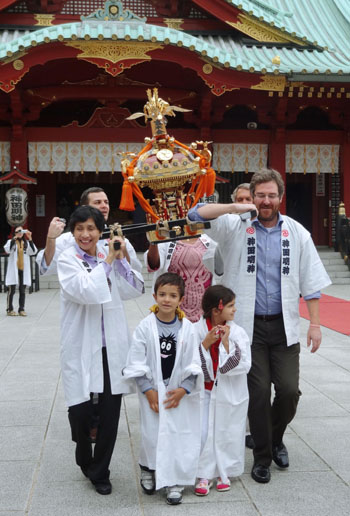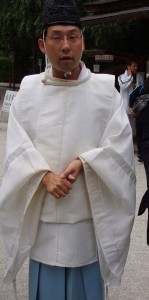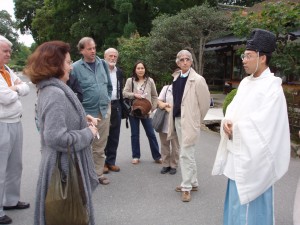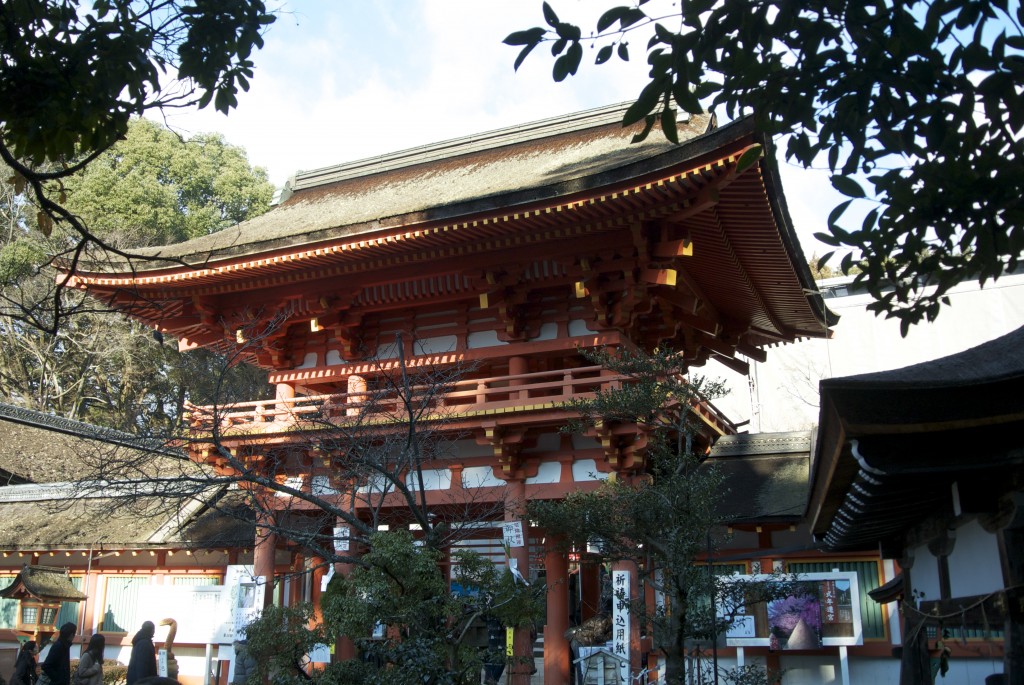An article in the Japan Times today focusses on Shinto’s attempts to explain itself to the outside world. Note that this is not the same as spreading Shinto to foreigners, but simply a desire to increase international awareness of Shinto.
+++++++++++++++++++++++++

Hands-on Shinto: Diplomats and their families in happi coats carry a portable shrine at Kanda Myojin Shrine during an Oct. 27 seminar for foreign envoys stationed in Japan. KYODO
Tuesday, Jan. 15, 2013 By TAKESHI NISHIDE (Kyodo)
Shinto trying to stay relevant in global, green era
Priests becoming more proactive in explaining cultural nuances of native religion to foreigners
One morning last fall, a group of around a dozen people of various nationalities and religious faiths visited Kanda Myojin Shrine in central Tokyo.
The diplomats and their families from various countries in Europe, Latin America and Africa, including Luxembourg, Romania and Costa Rica, were participating in an Oct. 26-27 Shinto seminar for foreign envoys stationed in Japan.
The seminar, the first of its kind, was organized by the Association of Shinto Shrines, the umbrella organization for the 80,000 or so shrines scattered across Japan.
On the first day, the participants received lessons on the Shinto elements of life in Japan, such as the practice of visiting a shrine at the beginning of a new year and the traditional “shichi-go-san” rite of passage for children aged 3, 5 and 7.
During the group’s visit to Kanda Myojin on the second day, the participants went through the rituals of worship and then practiced taking part in carrying “mikoshi” (portable shrines) in a procession while wearing traditional happi coats and making the traditional “wasshoi” chant.
One diplomat welcomed the occasion as a hands-on cultural experience, while another said the seminar offered a glimpse into how the Japanese look at life and nature via the influence of Shinto.
The seminar was one of several unrelated initiatives intended to promote the understanding of Shinto outside Japan and use it as a means of cultural exchange in an era of globalization.

Inui Mitsutaka of Kamigamo Shrine, Kyoto
Katsuji Iwahashi, a lecturer at Kokugakuin University in Tokyo, is teaching a course to help would-be Shinto priests develop English communications skills.
Iwahashi is frequently asked by foreigners about the concept of deities in Shinto.
He explained that the people may recognize a god wherever they feel the presence of something supernatural, referring to the ephemeral nature of Shinto gods compared with the distinct identity of the Christian or Muslim God.
Iwahashi believes the vagueness that is the hallmark of Shinto can be effective in dealing with the demands of modern society.
“I am not trying to spread Shinto around the world. I’m hoping to help people understand the Shinto mind that is different from digital thinking,” he said.
In the ancient capital of Kyoto, Mitsutaka Inui, a priest at Kamigamo Shrine, a World Heritage site, is trying to get foreign tourists to become familiar with the religion.
When receiving foreign visitors, Inui explains in English the history of the shrine, as well as some of the rituals and concepts unique to Shinto.
“Shinto is a religion of experiences,” Inui said, stressing the importance of engaging in practical activities. He is considering a plan to launch a sleepover Shinto experience program for foreign visitors that involves such activities as sweeping the shrine precincts early in the morning and hand-copying religious writings.

Inui sensei explaining some points to a group of visitors at Kamigamo Shrine
Inui, who was born in a salaried worker’s family but who has a Shinto priest among his ancestors, decided to become a priest while in junior high school.
Instead of enrolling with a Shinto-affiliated university as prospective priests usually do, Inui studied at Ritsumeikan University, a nonreligious institution. As he wanted to develop a global perspective, Inui devoted himself to studying Esperanto, an artificial language created as a means of international communication, as an extracurricular club activity.
After becoming a priest at Kamigamo Shrine, Inui saw tour guides give foreign tourists misleading information about Shinto by explaining it in terms of monotheism.
He came to the conclusion that the best way to prevent foreign visitors from developing erroneous perceptions is for priests themselves to communicate with them, so he strived to develop his English skills at the Interfaith Center of New York while working there under a temporary transfer program.
Inui believes Shinto can continue to gain people’s interest as something that transcends the everlasting march of science and technology.
“The thinking that we must not pollute water because a god resides in it helps to keep water and nature in pristine condition,” he said.

Kamigamo Shrine shining in the sunshine on New Year's day...

In searching for information on Shinto shrines, I have come across your blog. Thank you for a very interesting post. I should think that a conversation with a Shinto priest would be fascinating. The diplomats you mention have truly had a special experience. I look forward to reading more–a great resource!
I think these are all excellent ideas, and I’m pleased to see that there are Shinto priests in Japan thinking about it and trying to make Shinto more visible to the rest of the world.
I think more English access will be a big help, both on-line and in Japan.
I do wonder if “sweeping the shrine precincts early in the morning and hand-copying religious writings” is the best way to engage visitors and make them interested in the experience and deeper meanings of Shinto. They might be interesting parts of an overnight visit, or the connection to Shinto that those things bring might be lost on visitors. I wonder if a hike to visit a remote, natural place of kami would be more compelling, or something very personally involving like misogi or dance.
It’s hard to say what will resonate with different people, however, and I think the bigger idea of making Shinto more visible and better understood is far more important than the details of how that’s done. Details can always be changed.
Thanks for the thoughts… I agree with you in principle, though Shinto does not offer obvious opportunities for experience such as staying overnight in a Zen temple, for example. Rituals, festivals and visiting sacred spots are probably as much as can be offered. Misogi is not as common as one might think. But in terms of spreading awareness of Shinto to the outside world, I suppose that is the purpose of the International Shinto Foundation, though I’ve heard mixed reports about it. Its mission statement runs as follows; “The International Shinto Foundation was established in 1994 as a voluntary organization to promote the academic and cultural study of Shinto and to deepen understanding of Shinto internationally, and was certified as a Non-Profit Organization by the Governor of Tokyo in 2000. The International Shinto Foundation is not a religious organization aiming to propagate Shinto.”
I thought of this post just the other day, when I was looking at http://inari.jp/. It’s clearly an important site, but the only English on the site is “Copyright © Fushimi Inari Taisha, All Rights Reserved.”
Thanks to the wonders of mechanical translation, the site is somewhat navigable, although there are some unintentionally hilarious translations: “Fushimi Inari Shrine rich harvest, as the god of prosperity, worshiped thick. We are looking forward to the visit of everyone please, if you are willing to pray the prayer answered and safe delivery, convalescence all kinds of diseases, such as academic achievement.”
I had no idea academic achievement was a disease!
Goofy automatic translation aside, I’m sure that Fushimi Inari is a large enough organization to support an English web site. While this isn’t true of many of the shrines, there are some large ones that certainly could do so. Perhaps the International Shinto Foundation could encourage those larger organizations to make more of their web site more accessible.
Good day, Lou… thanks for bringing that up, and that translation certainly is humorous. The outreach in terms of English seems to vary from shrine to shrine, depending on the interests of the priests. I’ve found small shrines with very good English language explanations which are given away free, generously enough. On the other hand some large shrines don’t have English language explanations at all. Websites take time and effort, so I guess it’s fairly down the list of priorities for some shrines. Perhaps it’s just a matter of time… or waiting until mechanical translation gets good enough to do the job.